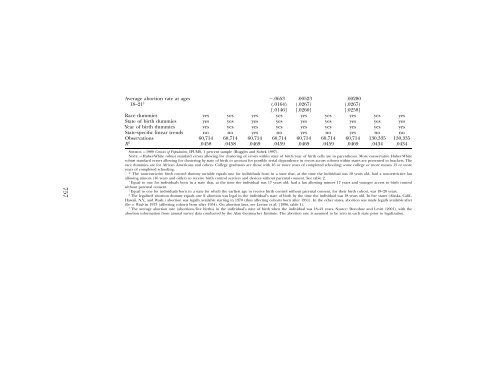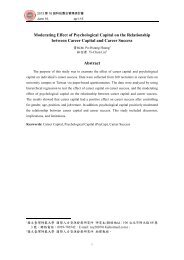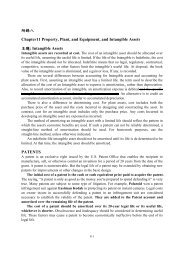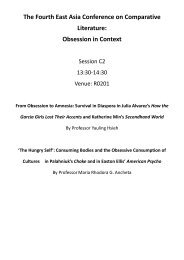The Power of the Pill: Oral Contraceptives and Women's ... - Mail
The Power of the Pill: Oral Contraceptives and Women's ... - Mail
The Power of the Pill: Oral Contraceptives and Women's ... - Mail
Create successful ePaper yourself
Turn your PDF publications into a flip-book with our unique Google optimized e-Paper software.
757<br />
Average abortion rate at ages<br />
.0653<br />
18–21 k (.0164)<br />
[.0146]<br />
.00523<br />
(.0267)<br />
[.0260]<br />
.00280<br />
(.0267)<br />
[.0258]<br />
Race dummies yes yes yes yes yes yes yes yes yes<br />
State <strong>of</strong> birth dummies yes yes yes yes yes yes yes yes yes<br />
Year <strong>of</strong> birth dummies yes yes yes yes yes yes yes yes yes<br />
State-specific linear trends no no yes no yes no yes no no<br />
Observations 60,714 60,714 60,714 60,714 60,714 60,714 60,714 130,335 130,335<br />
2<br />
R .0458 .0458 .0469 .0459 .0469 .0459 .0469 .0434 .0434<br />
Source.—1980 Census <strong>of</strong> Population, IPUMS, 1 percent sample (Ruggles <strong>and</strong> Sobek 1997).<br />
Note.—Huber-White robust st<strong>and</strong>ard errors allowing for clustering <strong>of</strong> errors within state <strong>of</strong> birth/year <strong>of</strong> birth cells are in paren<strong>the</strong>ses. More conservative Huber-White<br />
robust st<strong>and</strong>ard errors allowing for clustering by state <strong>of</strong> birth to account for possible serial dependence in errors across cohorts within states are presented in brackets. <strong>The</strong><br />
race dummies are for African Americans <strong>and</strong> o<strong>the</strong>rs. College graduates are those with 16 or more years <strong>of</strong> completed schooling; some college or more means 13 or more<br />
years <strong>of</strong> completed schooling.<br />
* <strong>The</strong> nonrestrictive birth control dummy variable equals one for individuals born in a state that, at <strong>the</strong> time <strong>the</strong> individual was 18 years old, had a nonrestrictive law<br />
allowing minors (16 years <strong>and</strong> older) to receive birth control services <strong>and</strong> devices without parental consent. See table 2.<br />
†<br />
Equal to one for individuals born in a state that, at <strong>the</strong> time <strong>the</strong> individual was 17 years old, had a law allowing minors 17 years <strong>and</strong> younger access to birth control<br />
without parental consent.<br />
‡<br />
Equal to one for individuals born in a state for which <strong>the</strong> earliest age to receive birth control without parental consent, for <strong>the</strong>ir birth cohort, was 18–20 years.<br />
§<br />
<strong>The</strong> legalized abortion dummy equals one if abortion was legal in <strong>the</strong> individual’s state <strong>of</strong> birth by <strong>the</strong> time <strong>the</strong> individual was 18 years old. In five states (Alaska, Calif.,<br />
Hawaii, N.Y., <strong>and</strong> Wash.) abortion was legally available starting in 1970 (thus affecting cohorts born after 1951). In <strong>the</strong> o<strong>the</strong>r states, abortion was made legally available after<br />
Roe v. Wade in 1973 (affecting cohorts born after 1954). On abortion laws, see Levine et al. (1996, table 1).<br />
k<br />
<strong>The</strong> average abortion rate (abortions/live births) in <strong>the</strong> individual’s state <strong>of</strong> birth when <strong>the</strong> individual was 18–21 years. Source: Donohue <strong>and</strong> Levitt (2001), with <strong>the</strong><br />
abortion information from annual survey data conducted by <strong>the</strong> Alan Guttmacher Institute. <strong>The</strong> abortion rate is assumed to be zero in each state prior to legalization.















